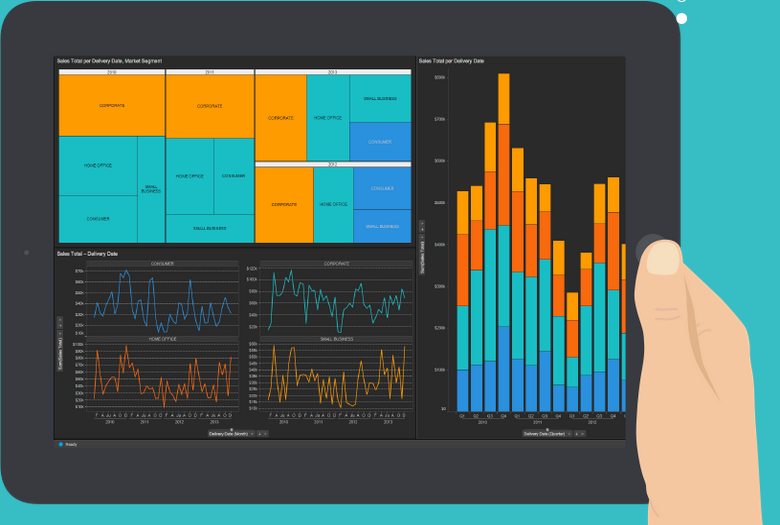
Inside TIBCO’s ‘Connected Intelligence’ Strategy

(ktsdesign/Shutterstock)
Not content to ride a comfortable stream of maintenance revenue into the sunset, TIBCO is on the move again as it builds out its “connected intelligence” strategy to be a one-stop shop for the evolving data integration, management, and analytics needs of Global 2000 firms.
TIBCO brought its annual user conference to San Diego, California last week, and made several customers and executives available to Datanami and its sister publication EntepriseTech. What was plainly evident from discussions with CTO Matt Quinn, CMO Thomas Been, and customers like JetBlue and Mercedes-AMG Petronas Motorsport is that the company is positioning itself to be a capable partner for solving enterprise-scale data challenges.
“A lot of the digital evolution we see requires those two capabilities: interconnect everything and augmented intelligence,” Been says in an interview. “These are two fundamental capabilities that are really required in a lot of domains that companies are working in.”
With its history as a top provider of enterprise messaging systems, TIBCO has always had a strong data integration story. Now the Palo Alto, California company is moving aggressively to leverage emerging technologies like the Internet of Things (IoT), Blockchain, artificial intelligence, and micro services to bolsters its clients’ capabilities.
Much of its analytics story rides atop Spotfire, the BI and visualization tool that TIBCO acquired several years ago to compete with Tableau, Qlik, and Microstrategy. TIBCO has plans to improve that product’s functioning through the use of data science, such as by issuing better recommendations for visualizations.

Spotfire is the linchpin of TIBCO’s analytics strategy
The recent acquisition of the Statistica package also factors into TIBCO’s data science plans. In addition to opening up access to the world of open source data science libraries, the Statistica software will also bolster its TIBCO Insight Platform and give users a way to leverage Google‘s TensorFlow framework for deep learning.
The company has plans to make its own AI offerings. Instead, it wants to leverage the accelerating rate of AI advancements to improve its own product offerings in specific areas. “I have no desire to build yet another AI framework. There’s already enough,” Quinn the CTO says. “What I am interested in is applying some of those technologies that have been built to make our technology better, and also to … do them at fundamental scale and speed.”
Graph database are in the plans, too. TIBCO is actually building its own semantic graph database, with the goal of being able to store and retrieve knowledge more effectively, which could have applications in a range of use cases and bolster other investments that customers are making in machine learning and IoT.
“Whenever you talk about AI, knowledge representation become a pretty big deal,” Quinn says. “If you go and look at what Google has done with TensorFlow, a lot of the outputs … are graphs. You need to store those graphs to be able to analyze those, so that graph database is a pretty important building block for us.”
Speaking of blocks, TIBCO is also quite keen on the Blockchain and distributed ledger technologies. “Blockchain is interesting,” Quinn says. “Specifically, the notion of smart contracts intrigues us quite a lot. The ability to provide rule-based smart contracts, that are more adaptive than just writing code, is something we’re pretty intrigued by.”
The company is also delving into “low code” environments with LiveApps, a cloud-based business process management (BPM) environment designed to allow non-technical users to assemble Web apps quickly.

Murray Rode leads TIBCO as CEO
Then there’s Project Mashling, a new open source “micro gateway” designed to help clients manage the multitude of microservices APIs. Mashling is an extension of Mashery, the full-fledged API management product that it bought from Intel in 2015. Last but not least is Project Flogo, a lightweight, open source product that can run on any device and functions as an IoT integration engine. Together, Flogo and Mashling are key to TIBCO’s strategy to push its “connected intelligence” strategy out to edge devices.
TIBCO has a lot of irons in the fire (and we didn’t even talk about its in-memory data grid or streaming analytics offerings). From machine learning and AI to IoT and Blockchain, it’s spreading its technological bets around in a fairly even manner. But the company is fully aware of the high hype level accompanying these technologies, and displays a cautious prudence that doesn’t exist at many venture-backed firms in the Silicon Valley.
If the level of hype hit 100 on a hypothetical hypo-o-meter, says Been the CMO, then perhaps we can expect the real-world impact of those technologies to register a 30. “We talk about fascinating technologies,” he says. “But if we don’t connect them to the real business, well, they’re going to go the same route as Hadoop and the others.”
TIBCO has been in a state of transition since it was sold by founder Vivek Ranadivé and transitioned from a public to a private entity. Now 20 years old, the company is entering its third decade with a solid collection of products and a thorough understanding enterprise computing needs. When you combine that with the wider dynamics occurring in the computing world, it could add up to something special.
Related Items:
In-Memory Data Grid Key to TIBCO’s Strategy
Please Stop Chasing Yellow Elephants, TIBCO CTO Pleads






























